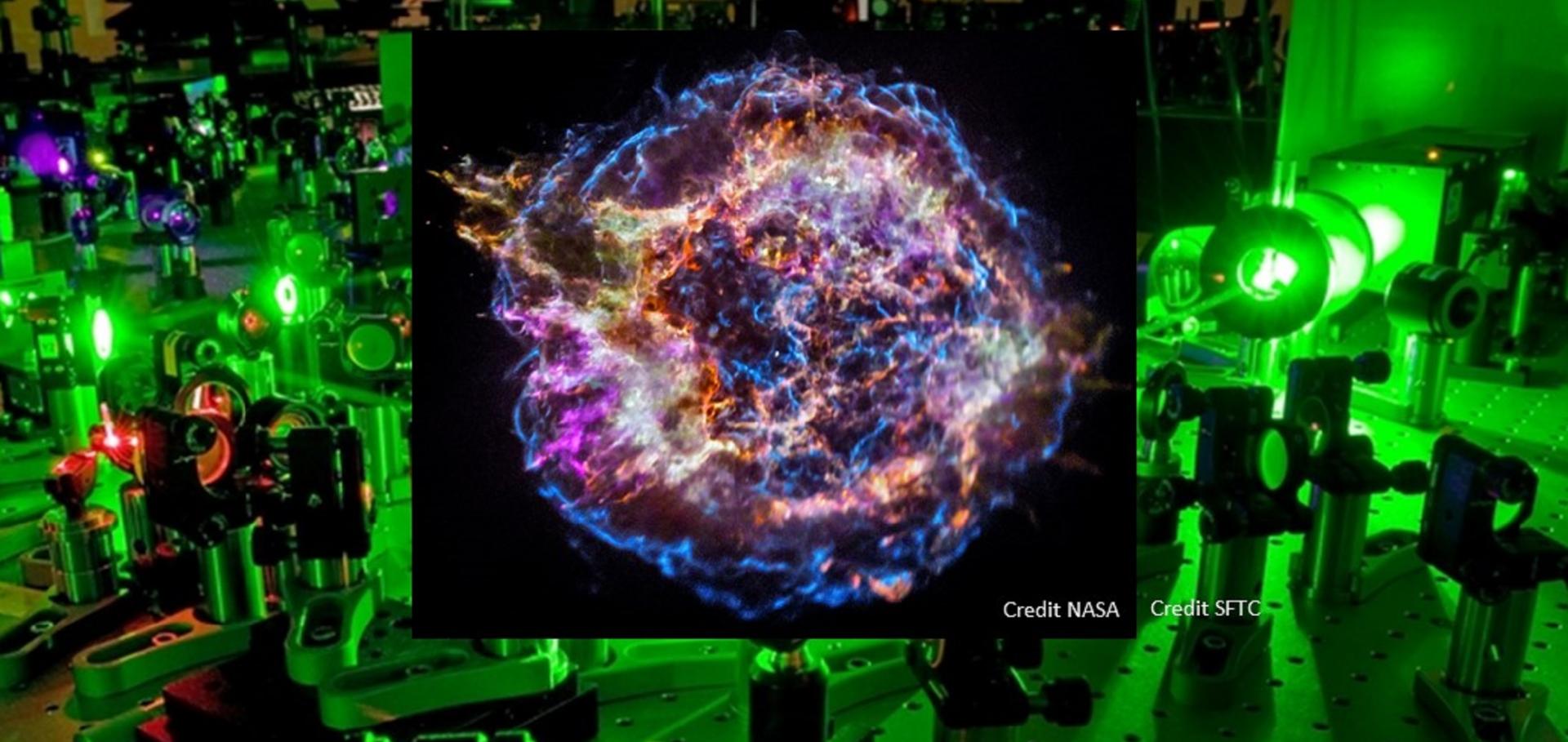Insensitivity of a turbulent laser-plasma dynamo to initial conditions
Matter and Radiation at Extremes AIP Publishing 7:4 (2022) 046901
Abstract:
It has recently been demonstrated experimentally that a turbulent plasma created by the collision of two inhomogeneous, asymmetric, weakly magnetized, laser-produced plasma jets can generate strong stochastic magnetic fields via the small-scale turbulent dynamo mechanism, provided the magnetic Reynolds number of the plasma is sufficiently large. In this paper, we compare such a plasma with one arising from two pre-magnetized plasma jets whose creation is identical save for the addition of a strong external magnetic field imposed by a pulsed magnetic field generator. We investigate the differences between the two turbulent systems using a Thomson-scattering diagnostic, x-ray self-emission imaging, and proton radiography. The Thomson-scattering spectra and x-ray images suggest that the external magnetic field has a limited effect on the plasma dynamics in the experiment. Although the external magnetic field induces collimation of the flows in the colliding plasma jets and although the initial strengths of the magnetic fields arising from the interaction between the colliding jets are significantly larger as a result of the external field, the energies and morphologies of the stochastic magnetic fields post-amplification are indistinguishable. We conclude that, for turbulent laser-plasmas with supercritical magnetic Reynolds numbers, the dynamo-amplified magnetic fields are determined by the turbulent dynamics rather than the seed fields or modest changes in the initial flow dynamics of the plasma, a finding consistent with theoretical expectations and simulations of turbulent dynamos.Time-resolved turbulent dynamo in a laser plasma
Proceedings of the National Academy of Sciences National Academy of Sciences 118:11 (2021) e2015729118
Abstract:
Understanding magnetic-field generation and amplification in turbulent plasma is essential to account for observations of magnetic fields in the universe. A theoretical framework attributing the origin and sustainment of these fields to the so-called fluctuation dynamo was recently validated by experiments on laser facilities in low-magnetic-Prandtl-number plasmas (Pm<1). However, the same framework proposes that the fluctuation dynamo should operate differently when Pm≳1, the regime relevant to many astrophysical environments such as the intracluster medium of galaxy clusters. This paper reports an experiment that creates a laboratory Pm≳1 plasma dynamo. We provide a time-resolved characterization of the plasma’s evolution, measuring temperatures, densities, flow velocities, and magnetic fields, which allows us to explore various stages of the fluctuation dynamo’s operation on seed magnetic fields generated by the action of the Biermann-battery mechanism during the initial drive-laser target interaction. The magnetic energy in structures with characteristic scales close to the driving scale of the stochastic motions is found to increase by almost three orders of magnitude and saturate dynamically. It is shown that the initial growth of these fields occurs at a much greater rate than the turnover rate of the driving-scale stochastic motions. Our results point to the possibility that plasma turbulence produced by strong shear can generate fields more efficiently at the driving scale than anticipated by idealized magnetohydrodynamics (MHD) simulations of the nonhelical fluctuation dynamo; this finding could help explain the large-scale fields inferred from observations of astrophysical systems.Transport of high-energy charged particles through spatially-intermittent turbulent magnetic fields
Astrophysical Journal American Astronomical Society 892:2 (2020) 114
Abstract:
Identifying the sources of the highest energy cosmic rays requires understanding how they are deflected by the stochastic, spatially intermittent intergalactic magnetic field. Here we report measurements of energetic charged-particle propagation through a laser-produced magnetized plasma with these properties. We characterize the diffusive transport of the particles experimentally. The results show that the transport is diffusive and that, for the regime of interest for the highest-energy cosmic rays, the diffusion coefficient is unaffected by the spatial intermittency of the magnetic field.Cosmic ray acceleration by shocks: spectral steepening due to turbulent magnetic field amplification
Monthly Notices of the Royal Astronomical Society Oxford University Press 488*:2 (2019) 2466-2472
Abstract:
We show that the energy required to turbulently amplify magnetic field during cosmic ray (CR) acceleration by shocks extracts energy from the CR and steepens the CR energy spectrum.Cosmic ray acceleration in hydromagnetic flux tubes
Monthly Notices of the Royal Astronomical Society Oxford University Press 487:4 (2019) 4571-4579


